 W
W1943: The Battle of Midway is a 1987 shoot 'em up arcade game developed and published by Capcom. It was the first followup to Capcom's earlier 1942. The game's name is a reference to the Battle of Midway, which in actuality happened in June 1942.
 W
WAero Fighters, known as Sonic Wings in Japan, is a vertically scrolling shooter originally released in arcades in 1992 by Video System and ported to the Super Nintendo Entertainment System in 1993. It was the first in the Aero Fighters series, and a spiritual successor to the 1991 Turbo Force.
 W
WBattle City is a multi-directional shooter video game for the Family Computer produced and published in 1985 by Namco. It is a successor to Namco's 1980 Tank Battalion, and would be succeeded itself by the 1991 Tank Force.
 W
WCapcom Arcade Stadium is an upcoming compilation of classic arcade video games for Nintendo Switch, to be released via the eShop in February 2021. The compilation of 32 games that were originally released by Capcom in arcades from 1984 to 2001, comes with 1943: The Battle of Midway and the rest are downloadable content. Being based on emulation gives the compilation the features of real-time rewind, difficulty selection, adjustable game speed, and nostalgic visual filters to simulate vintage arcade CRT screens.
 W
WContra is a run and gun video game developed and published by Konami, originally released as a coin-operated arcade game on February 20, 1987. A home version was released for the Nintendo Entertainment System in 1988, along with ports for various computer formats, including the MSX2. The home versions were localized in the PAL region as Gryzor on the various computer formats and as Probotector on the NES, released later. Several Contra sequels were produced following the original game.
 W
WDaytona USA is a racing game developed by Sega AM2 and released by Sega in Japan in 1993 and worldwide in 1994. Players race stock cars on one of three courses. The first game released on the Sega Model 2 arcade system board, Daytona USA is one of the highest-grossing arcade games of all time.
 W
WDungeons & Dragons: Shadow over Mystara is an arcade game developed and published by Capcom in 1996 as a sequel to Dungeons & Dragons: Tower of Doom. The game is set in the Dungeons & Dragons campaign setting of Mystara.
 W
WDunk Star is an unreleased 1991 basketball arcade video game that was in development and planned to be published by Sammy for the arcade Neo Geo MVS and Neo Geo AES home console. Had it been launched before Street Slam, it would have become the first basketball title for the Neo Geo platforms.
 W
WExed Exes is a vertically scrolling shooter that was released in arcades in 1985 by Capcom.
 W
WF355 Challenge is a racing simulation arcade video game based on the actual race car and Ferrari event. It was developed by the AM2 division of Sega for the Sega Naomi Multiboard arcade system board under the direction of Yu Suzuki, and was later ported to the Dreamcast and PlayStation 2 home video game consoles under the names F355 Challenge: Passione Rossa and Ferrari F355 Challenge respectively for both American and European releases. The only model of car featured in the game is the Ferrari F355 Challenge model. The game was considered the most accurate simulation of the F355 possible up until that time.
 W
WFerrari GT: Evolution is a racing game by Gameloft Bucharest based on up to 33 different cars, all manufactured by Ferrari. Races take place on the Fiorano Circuit and seven imaginary road circuits, each based on an actual city.
 W
WGhostlop is an unreleased 1996 puzzle arcade video game that was in development by Data East and planned to be published by SNK for the Neo Geo MVS (arcade), Neo Geo AES (home) and Neo Geo CD. In the game, players assume the role of ghosthunters Bruce and McCoy from the Data Ghost agency to evict mischievous ghosts across multiple locations. Its gameplay mainly consists of puzzle mixed with Breakout-style action elements using a main two-button configuration.
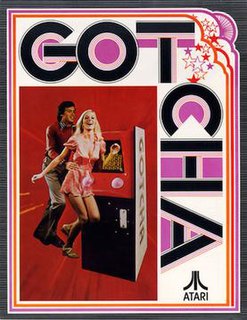 W
WGotcha is an arcade game developed by Atari and released in October 1973. It was the fourth game by the company, after the 1972 Pong, which marked the beginning of the commercial video game industry, and the 1973 Space Race and Pong Doubles. In the game, two players move through a maze, which continually changes over time. One player, the Pursuer, attempts to catch the other, the Pursued; if they do, a point is scored, and the players reset positions. The game emits an electronic beeping sound, which increases in pace as the Pursuer gets closer to the Pursued, and each game lasts a set amount of time.
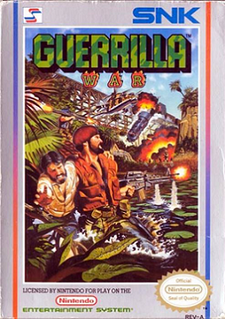 W
WGuerrilla War, released in Japan as Guevara (ゲバラ), is an overhead run and gun game produced by SNK. Originally released for arcades in 1987 as a coin-operated arcade game, Guerrilla War was later ported to Amstrad CPC, Apple II, Commodore 64, NES, PlayStation Network, and ZX Spectrum.
 W
WGunForce II is a run and gun arcade video game developed and originally published by Irem on September 1994. It is the sequel to the original GunForce and one of the last arcade games, if not the last to be released by the company before ceasing development of video games in the same year, after which a group of employees from the gaming division of Irem would go on to form Nazca Corporation due to being tired of the company's inactivity.
 W
WThe House of the Dead 4 is a horror-themed light gun arcade game and the fourth installment of the House of the Dead series of video games, developed by Sega. The game takes place between the events of The House of the Dead 2 and The House of the Dead III, and introduced several new gameplay concepts. Players can control characters James Taylor, from The House of the Dead 2, or Kate Green, a new character to the series. The game was followed by House of the Dead: Scarlet Dawn.
 W
WHouse of the Dead: Scarlet Dawn is a horror-themed rail shooter arcade game developed by Sega Interactive, and is the fifth title in The House of the Dead series, following the release of The House of the Dead 4 in 2005.
 W
WIce Climber is a vertical platform video game developed and published by Nintendo for the Nintendo Entertainment System in 1985. In Ice Climber, the characters Popo and Nana, collectively known as the Ice Climbers, venture up 32 ice-covered mountains to recover stolen vegetables from a giant condor. In some European countries, the NES console was sold bundled with the game, increasing Ice Climber's familiarity outside Japan.
 W
WJoust is an arcade game developed by Williams Electronics and released in 1982. It popularized the concept of two-player cooperative gameplay by being more successful at it than its predecessors. The player uses a button and joystick to control a knight riding a flying ostrich. The objective is to progress through levels by defeating waves of enemy knights riding buzzards.
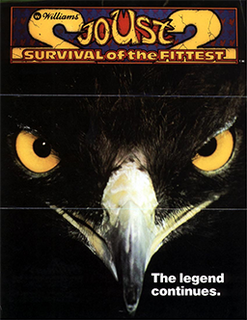 W
WJoust 2: Survival of the Fittest is an arcade game developed by Williams Electronics and released in 1986. It is a sequel to Williams' 1982 game Joust. Like its predecessor, Joust 2 is a 2D aerial combat game with platforms to land on. The player uses a button and joystick to control a knight riding a flying ostrich. The object is to progress through levels by defeating groups of enemy knights riding buzzards. Joust 2 features improved audio-visuals and new features such as mutant buzzards created by eggs falling into lava, the ability to transform from an ostrich to a flying horse, and differently themed levels. Waves no longer seamlessly flow into each other; the gameplay is divided into separate screens with transitions between them.
 W
WKidō Senshi Gundam: Senjō no Kizuna, is a Japanese arcade game set in the original Gundam universe. The game was created by Bandai Namco and Banpresto and was released late 2006. Play involves stepping into a P.O.D. and doing battle with other players across Japan.
 W
WMetal Slug is a 1996 run and gun arcade video game originally developed by Nazca Corporation and released by SNK for the Neo Geo MVS. It is the first installment in the eponymous series. Set in 2028, players assume the role of Peregrine Falcon Strike Force soldiers Marco Rossi and Tarma Roving on a fight against the Rebel Army led by Donald Morden and overthrow his coup d'état to prevent a New World Order.
 W
WMortal Kombat II is a fighting game originally produced by Midway for the arcades in 1993. It was later ported to multiple home systems, including the MS-DOS, Amiga, Game Boy, Game Gear, Sega Genesis, 32X, Sega Saturn, Super Nintendo Entertainment System, and PlayStation only in Japan, mostly in licensed versions developed by Probe Entertainment and Sculptured Software and published by Acclaim Entertainment.
 W
WPigskin 621 A.D. is an arcade game released in 1990 by Bally Midway. One player can battle the computer, or two players can battle head-to-head. Two teams compete to score as many touchdowns as possible in the tradition of American football, but actual play is more similar to rugby football.
 W
WPleasure Goal: 5 on 5 Mini Soccer is a 1996 futsal arcade video game developed by Saurus and published by SNK. In the game, players compete against either AI-controlled opponents or other players in matches across various stadiums. The title was created by most of the same team that would later work on future projects at Saurus such as Shock Troopers. Though first launched for Neo Geo MVS, it was later released for Neo Geo CD and has since been re-released through download services on various consoles.
 W
WPong is a table tennis–themed arcade video game, featuring simple two-dimensional graphics, manufactured by Atari and originally released in 1972. It was one of the earliest arcade video games; it was created by Allan Alcorn as a training exercise assigned to him by Atari co-founder Nolan Bushnell, but Bushnell and Atari co-founder Ted Dabney were surprised by the quality of Alcorn's work and decided to manufacture the game. Bushnell based the game's concept on an electronic ping-pong game included in the Magnavox Odyssey, the first home video game console. In response, Magnavox later sued Atari for patent infringement.
 W
WPower Spikes II is a volleyball arcade video game developed by Video System and originally published by Taito on October 19, 1994. A follow-up to Hyper V-Ball on Super Nintendo Entertainment System, it was first launched for Neo Geo MVS (arcade) and later ported to Neo Geo CD. It is the final installment in the Super Volleyball series.
 W
WPuzzle Bobble is a 1994 tile-matching arcade puzzle video game for one or two players created by Taito. It is based on Taito's 1986 arcade game Bubble Bobble, featuring characters and themes from that game. Its characteristically cute Japanese animation and music, along with its play mechanics and level designs, made it successful as an arcade title and spawned several sequels and ports to home gaming systems.
 W
WRampage is a 1986 arcade game by Bally Midway. Players take control of a trio of gigantic monsters trying to survive against onslaughts of military forces. Each round is completed when a particular city is completely reduced to rubble. Warner Bros. currently owns all rights to the property via their purchase of Midway Games.
 W
WSarge is an arcade game released by Bally Midway in 1985. Two players play at once, switching between tanks and helicopters. Players can fight each other. The game has two sets of joysticks.
 W
WScud Race, known as Sega Super GT in North America, is an arcade racing video game released by Sega in 1996. It is the first racing game to use the Sega Model 3 hardware.
 W
WSmash TV is a 1990 arcade game created by Eugene Jarvis and Mark Turmell for Williams. It is a dual-stick shooter in the same vein as 1982's Robotron: 2084. The Super NES, Genesis, Master System, and Game Gear versions were titled Super Smash TV.
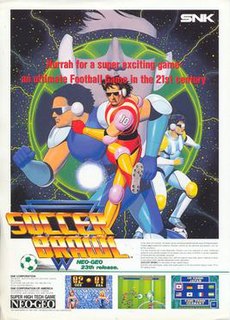 W
WSoccer Brawl is a futuristic soccer game first released in arcades on February 14, 1992. It was available on the Neo Geo on March 13 the same year and later for the Neo Geo CD on March 31, 1995.
 W
WSpace Duel is an arcade game released in 1982 by Atari, Inc. It is a direct descendant of the original Asteroids, with asteroids replaced by colorful geometric shapes like cubes, diamonds, and spinning pinwheels. Space Duel is the first and only multiplayer vector game by Atari. When Asteroids Deluxe did not sell well, this game was taken off the shelf and released to moderate success.
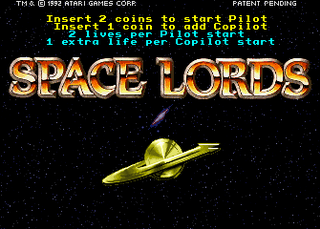 W
WSpace Lords is a video game released in arcades by Atari Games in 1992. It is a first-person perspective space combat video game which allows the player to fly in any direction.
 W
WSpace Race is an arcade game developed by Atari, Inc. and released on July 16, 1973. It was the second game by the company, after Pong (1972), which marked the beginning of the commercial video game industry. In the game, two players each control a rocket ship, with the goal of being the first to move their ship from the bottom of the screen to the top. Along the way are asteroids, which the players must avoid. Space Race was the first racing arcade video game and the first game with a goal of crossing the screen while avoiding obstacles.
 W
WSpace Wars is a competitive, two-player video game released in arcades in 1977 by Cinematronics. Like the 1962 PDP-1 program Spacewar! it is based on, it uses black and white vector graphics for the visuals. The hardware developed for Space Wars became the platform for most of the vector-based arcade games from Cinematronics. A Vectrex port was published in 1982.
 W
WStakes Winner is a horse racing arcade video game developed by Saurus, with additional support from AM Factory, and originally published by SNK on September 27, 1995. In the game, players compete with either AI-controlled opponents or against other human players across multiple races. Though it was initially launched for the Neo Geo MVS (arcade), the title was later released for both Neo Geo AES (home) and Neo Geo CD respectively, in addition of being ported and re-released through download services for various consoles. It was received with mixed reception from critics and reviewers since its initial release. In 1996, a sequel titled Stakes Winner 2 was released for the arcades.
 W
WStakes Winner 2 is a horse racing arcade video game developed by Saurus, with additional support from AM Factory, and originally published by SNK on September 24, 1996. It is the sequel to the original Stakes Winner, which was released earlier in 1995 on multiple platforms. In the game, players compete with either AI-controlled opponents or against other human players across multiple races. Though it was initially launched for the Neo Geo MVS (arcade), the title was later released to Neo Geo AES (home), in addition of being ported and re-released through download services for various consoles. Like its predecessor, it was received with mixed reception from critics and reviewers since its initial release. A third entry, Stakes Winner 3, was rumored to be in development but never released.
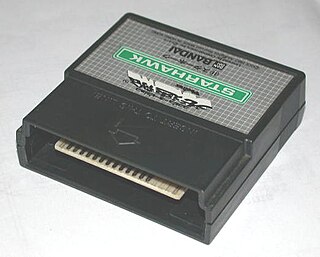 W
WStarhawk is a 1979 vector arcade game designed and programmed by Tim Skelly and manufactured by Cinematronics. Starhawk is a shoot 'em up unofficially based on the Star Wars: Episode IV trench run, the first arcade game to blatantly use concepts from Star Wars. The game was unique at the time for its pseudo-3D graphics. It was released for the Vectrex home system in 1982.
 W
WSteel Talons is a 3D arcade game released by Atari Games in 1991. The player takes on the role of a pilot for an "AT1196 Steel Talons combat helicopter". Steel Talons was ported to the Sega Genesis, Atari Lynx, Atari ST, and the Super Nintendo Entertainment System. A Jaguar port was announced, but never released.
 W
WStreet Fighter IV is a 2008 fighting game published by Capcom, who also co-developed the game with Dimps. It was the first original main entry in the series since Street Fighter III in 1997, a hiatus of eleven years.
 W
WStreet Slam is a basketball video game developed by Data East for Neo Geo, released in 1994. The game features three-on-three basketball match-ups with a variety of different teams.
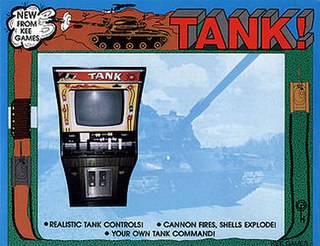 W
WTank is an arcade game developed by Kee Games, a subsidiary of Atari, and released in November 1974. It was the only original title not based on an existing Atari property developed by Kee Games, which was founded to sell clones of Atari games to distributors as a fake competitor prior to the merger of the two companies. In the game, two players drive tanks through a maze viewed from above while attempting to shoot each other and avoid mines, represented by X marks, in a central minefield. Each player controls their tank with a pair of joysticks, moving them forwards and back to drive, reverse, and steer, and firing shells with a button to attempt to destroy the other tank. The destruction of a tank from a mine or shell earns the opposing player a point, and tanks reappear after being destroyed. The winner is the player with more points when time runs out, with each game typically one or two minutes long.
 W
WTank Force is a 1991 multi-directional shooter arcade game developed and published in Japan by Namco. It was designed by Yutaka Kounoe, whose works include Dig Dug, Lucky & Wild, and Point Blank. The game is the third installment in Namco's Tank Battalion series, following Battle City (1985). In 2017, it was re-released for the Nintendo Switch as part of the Namco Museum compilation.
 W
WTank! Tank! Tank! is a 2009 third-person shooter arcade game developed and published by Namco Bandai Games. It was ported to the Wii U in 2012, where it was a system launch title in North America. Players control their respective tanks and must destroy opponents and giant mechanical monsters with a variety of weapons, such as machine guns and rocket launchers. Its gameplay has been compared to titles such as the Earth Defense Force series, through its usage of B-movie tropes and parodying.
 W
WTokyo Wars is a 1996 first-person shooter arcade game developed and published by Namco.
 W
WTrack & Field is an Olympic-themed sports arcade game developed by Konami and released in 1983. The Japanese release sported an official license for the 1984 Summer Olympics. Players compete in a series of events, most involving alternately pressing two buttons as quickly as possible to make the onscreen character run faster. It was followed by Hyper Sports and other games in the series.
 W
WU.N. Squadron is a 1989 side-scrolling shooting game released by Capcom for the CPS arcade hardware and for the Super Nintendo Entertainment System. The game was released in Japan as Area 88 , and is based on the manga series of the same name, featuring the same main characters. Here, their mission is to stop a terrorist group known as Project 4. It was followed by a spiritual successor Carrier Air Wing.
 W
WVirtua Racing or V.R. for short, is a Formula One racing arcade game, developed by Sega AM2 and released in 1992. Virtua Racing was initially a proof-of-concept application for exercising a new 3D-graphics platform under development, the "Model 1". The results were so encouraging, that Virtua Racing was fully developed into a standalone arcade title. Though its use of 3D polygonal graphics was predated by arcade rivals Namco and Atari, Virtua Racing had vastly improved visuals in terms of polygon count, frame rate, and overall scene complexity, and displayed multiple camera angles and 3D human non-player characters, which all contributed to a greater sense of immersion. Virtua Racing is regarded as one of the most influential video games of all time, for laying the foundations for subsequent 3D racing games and for popularizing 3D polygonal graphics among a wider audience.
 W
WWizard of Wor is an arcade game released in 1980 by Midway. Up to two players fight together in a series of monster-infested mazes, clearing each maze by shooting the creatures. The game was ported to the Atari 8-bit family, Commodore 64, Atari 2600, and Atari 5200 and renamed to The Incredible Wizard for the Bally Astrocade. The original cartridge came with a cash prize offer to the first person to complete the game.